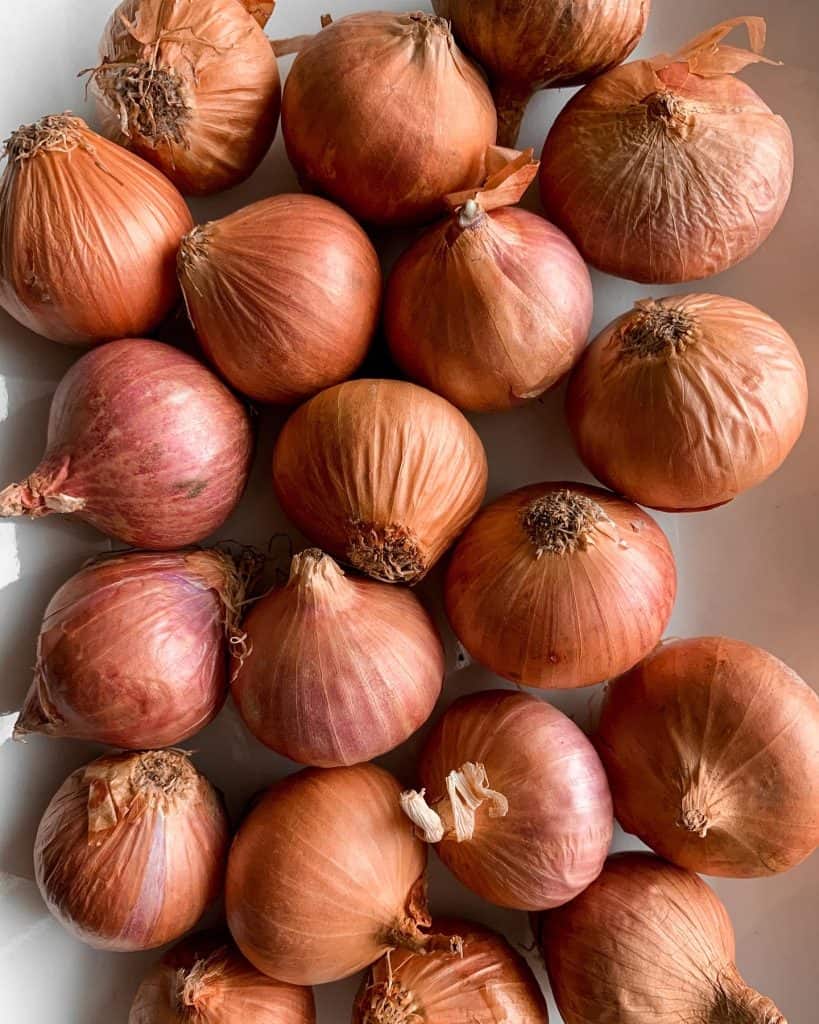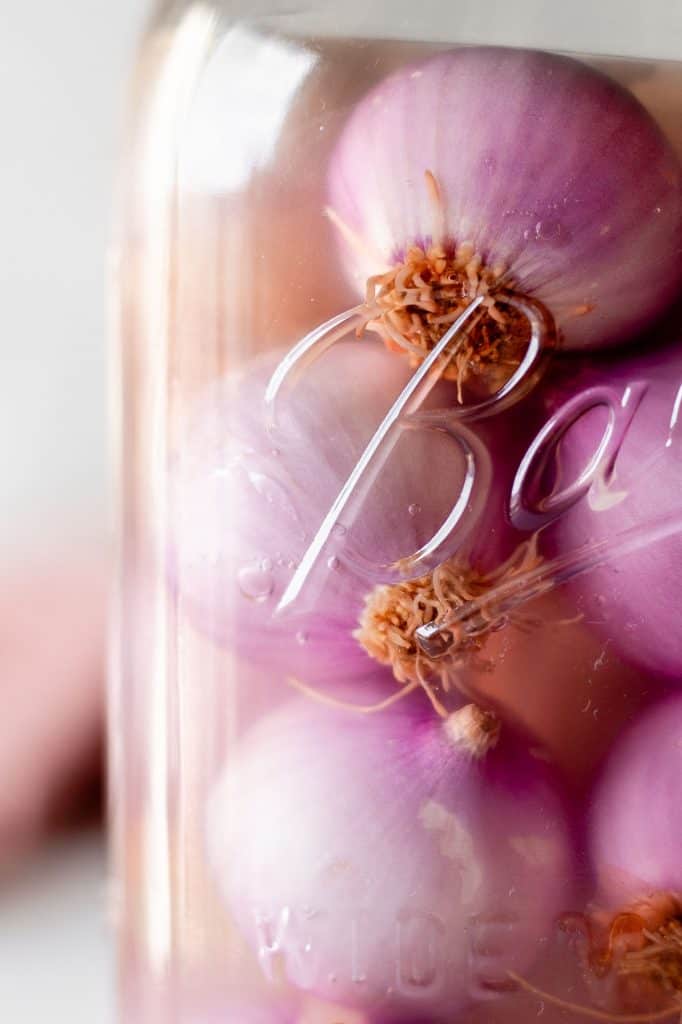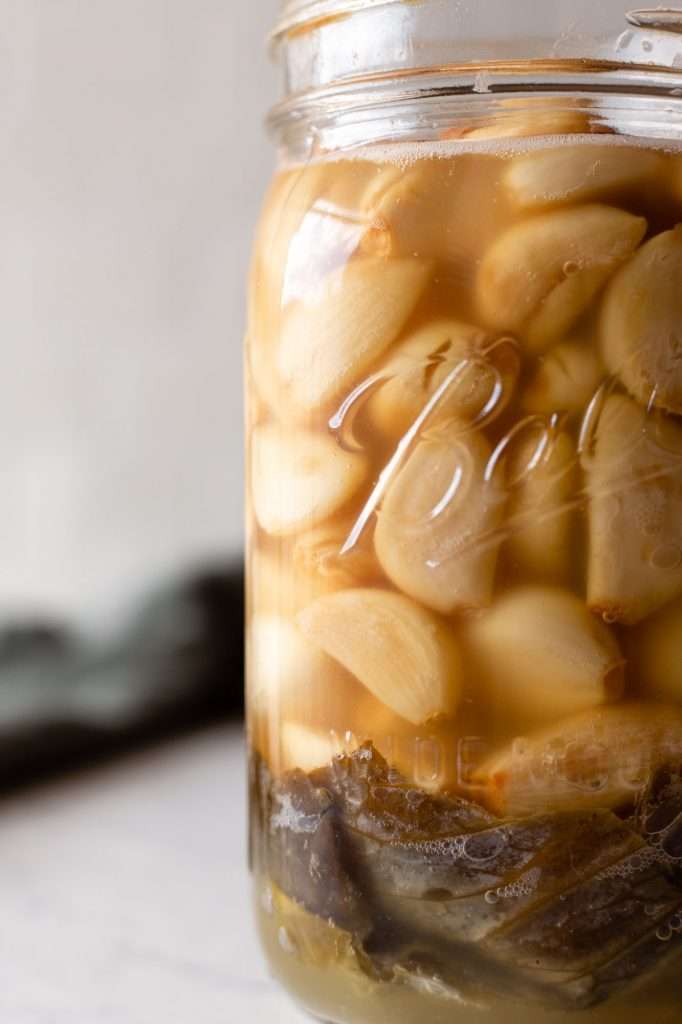Can You Ferment Shallots and Onions?
The short answer is, of course, you can! There are two ways to ferment shallots and onions. First, you can make fermented onions and shallots using a wild fermentation method. This method, unfortunately, doesn’t always work, though. Depending on where the onions or shallots come from, sometimes wild fermentation doesn’t work out well. The other option is to make fermented onions using a method I call “wild heirloom culturing.”
This recipe will teach you how to successfully use the wild fermentation method to lacto-ferment whole baby shallots. As you can see in the pictures here, I used the whole shallot, including the root ends. This is important because the root end is the main source of the wild lactic-acid-producing microbes required to facilitate the fermentation process.

What’s the difference between shallots and onions?
Shallots and onions are from the same plant family but are distinct and unique. The most obvious difference is onions are usually much larger than shallots. Onions are also more spherical in shape than shallots, and they grow in a single bulb. Shallots are usually more oblong and can grow in clusters, similar to garlic. When comparing flavor, shallots are sweeter and more subtle than onions.
When I bought the tiny shallots for this recipe, I was perplexed. They seemed like tiny onions because they are single bulbs with a definite spherical shape. The produce stand assured me that the little alliums pictured here are baby shallots, though.
Here’s how to choose quality shallots:
- make sure they are firm and fresh
- never use shallots that have signs of mold or fungal growth in the peel
- do not use already peeled and packaged shallots
- try to source shallots with the root end still attached


Equipment You Need to Make Fermented Shallots
Here’s all the supplies and equipment you will need to make this recipe:
- 32 ounce Wide Mouth Mason Jar
- Fermentation Weight
- Standard Metal Mason Jar Lid (this can rust in the presence of salt)
- OR Rust Free Plastic Lid
- or you can use a Weck Jar (without the gasket; only use the clips to secure the lid)
- Sea Salt
- Scale
- Mixing Bowl

How To Make Fermented Shallots
This recipe is quite simple. The hardest part is waiting for fermentation to be complete. First, you will measure all of the ingredients by weight. Next, you add the shallots, salt, and water to the glass mason jar, ensuring all the salt is dissolved. Last, place the glass fermentation weight in the jar to keep the shallots submerged and secure the lid. This recipe requires 5 weeks of fermentation for optimal flavor.
Once the fermentation is complete, I suggest checking the pH to make sure it’s below 4. You can do this with simple pH strips. You can store the shallots in the fridge and use them in all kinds of recipes. I suggest roasting them with Brussels sprouts, slicing and baking them into sourdough focaccia, or mincing and using them in salad dressings.
Do You Have Questions About Fermentation? Check Out These Fermentation Resources
- The Complete Guide to Safely Using Salt in Vegetable Fermentation
- How Long Does it Take to Ferment Vegetables?
- How to Keep Fermented Foods Anaerobic
- The Cultured Guru School of Fermentation
Other Fermentation Recipes to Try
- Learn How to Ferment Green Tomatoes
- Pepper Fermentation Recipe: Learn How to Ferment Any Type of Pepper
- Roasted Garlic Sauerkraut with Black Pepper


Simple Wild Fermented Shallots Recipe
Learn how to make wild fermented shallots with this easy and quick fermentation recipe! These shallots are crisp, juicy, umami, and tart. Enjoy these whole fermented shallots roasted in the oven with other vegetables, incorporated into loaves of bread, or slice them up and eat them raw in salads or on sandwiches.
- Prep: 10 minutes
- Total Time: 840 hours 10 minutes
Ingredients
- 500 grams small shallots
- 700 grams water
- 30 grams sea salt
Instructions
- Peel the shallots, keeping the root end intact. Lightly rinse the shallots in cool water.
- Dissolve the 30 grams of sea salt in 700 grams of water.
- Add the shallots to the 1-quart mason jar, and fill the jar with the water and salt mixture.
- Place your fermentation weight in the jar and make sure the weight and all shallots are submerged in the salt brine.
- Place the mason jar lid on the jar and secure it closed.
- Allow for fermentation at room temperature for 5 weeks.
- During the first three weeks, expect a lot of carbon dioxide production. You will need to gently open the jar lid to let some of the gas out daily. At the 3 week mark, you should notice the bubbles decreasing and eventually stopping completely.
- Check the pH at five weeks to ensure it is below four. Once it is, store the shallots in the fridge.
Notes
- It’s best to set the fermentation jar in a glass baking dish to catch any liquid that seeps out while it’s bubbling.
- The shallots will keep in the fridge for a year or two.




















Hi Kaitlynn!
When you mention about the a lot of C02 production in first 3 weeks of fermentation, I suddenly think about my kimchi recipe: I have fermented them for 3 months (90 days) at room temperature, at exact 2.5% salt concentration like you said, and now when i press down the weight, there is still a lot of bubbling and C02 production! and the taste of kimchi at this point are very sour now, which is expected. But i did not expect a lot of C02 production after such a long period of time, could you please explain why?
Thank you so much!
Sounds like secondary fermentation by yeasts in the kimchi. For lactic acid fermentation of kimchi, 3 months at room temperature is way too long. What all did you put in the kimchi? From what you are describing I’d say you have some root vegetables in there, like a lot of radishes and carrots maybe? Long periods of CO2 production happens when trying to wild ferment root vegetables. It’s because of all the sugars and usable carbohydrates in the roots.
Kaitlin, do you have any recommendations on how to salt ferment scallions? The percent salt, as well as other tips. Thanks.
I would just make 3% salt brine, add the scallions to a jar, top with the brine and a fermentation weight, then ferment the scallions for about 14 days before checking the pH to see if they are done.
Hi Kaitlynn,
Oof! I have been experimenting with ferments for a few months and decided to try with shallots, *before* reading your blog. I cut the root ends off, and notice I don’t have a very active ferment. Is this a problem? Will my shallots rot? They bubbled for a day or two and now the brine is cloudy, but not bubbling furiously like I’ve seen in past ferments. Should I toss them? They look and smell amazing, I don’t want to waste them just yet.
If you didn’t use my recipe, I’m not sure how it will turn out. There are a lot of recipe variables that can influence the outcome.